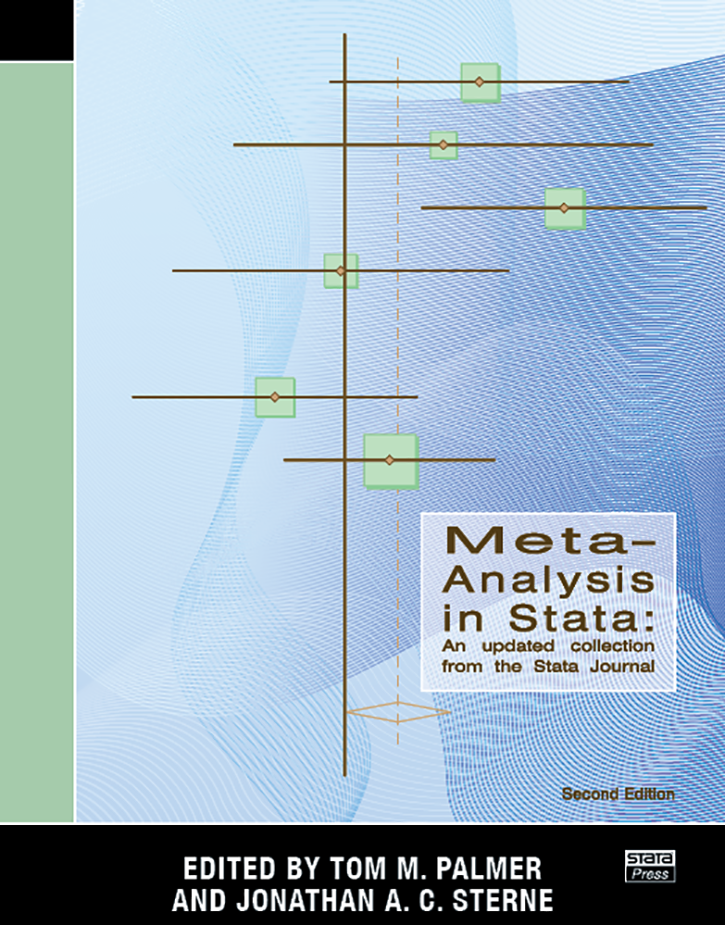
Meta-Analysis in Stata: An Updated Collection from the Stata Journal, Second Edition |
||||||||||||||||||||||||||||||||||||||
 Click to enlarge See the back cover |
$52.00 Print Buy now$42.00 VitalSource Buy now$41.50 Amazon Kindle Buy from Amazon
As an Amazon Associate, StataCorp earns a small referral credit from
qualifying purchases made from affiliate links on our site.
|
|
||||||||||||||||||||||||||||||||||||
|
Official meta-analysis commands are available in Stata 16. Stata 16 contains a suite of commands for performing meta-analysis. If you are using the official meta-analysis commands in Stata 16, the collection of Stata Journal articles is still valuable because the collection contains information about meta-analysis, and not just information on the community-contributed meta-analysis commands. We gratefully acknowledge the contributions of the Stata developers who wrote the community-contributed commands. |
||||||||||||||||||||||||||||||||||||||
Comment from the Stata technical groupMeta-analysis allows researchers to combine results of several studies into a unified analysis that provides an overall estimate of the effect of interest and to quantify the uncertainty of that estimate. Stata has some of the best statistical tools available for doing meta-analysis. The unusual thing about these tools is that none of them are part of official Stata. They are all created by and documented by experts in the broader research community who also happen to be proficient Stata developers. Editors Tom Palmer and Jonathan Sterne show how each of the articles in this collection relates to others and how each fits in the overall literature of meta-analysis. For the first edition, Sterne convinced over half the authors to update their software and articles for the collection. In this new edition, Palmer and Sterne have substantially expanded the scope of the collection to cover in more depth many contemporary advances that will help keep the reader up to date. The second edition retains its original topic-specific sections devoted to the fundamentals of meta-analysis: fitting models, meta-regression, and graphical and analytic tools for detecting bias. It also retains a section devoted to advanced methods. Readers of the first edition will find new articles in these sections, in particular ones that take advantage of major changes that occurred in Stata since the first edition, such as the introduction of the gsem command. This edition also adds three new topic-specific sections for multivariate or multiple outcomes meta-analysis, individual participant data (IPD) meta-analysis, and network meta-analysis. The addition of these sections gives readers access to new commands that address recent methodological developments in the field. The new edition adds 11 articles to the original collection of 16 articles. The articles cover topics ranging from standard and cumulative meta-analysis and forest plots to contour-enhanced funnel plots and nonparametric analysis of publication bias. In their articles, the authors present conceptual overviews of the techniques, thorough explanations, and detailed descriptions and syntax of new commands. They also provide examples using real-world data. In short, this collection is a complete introduction and reference for performing meta-analyses in Stata. |
||||||||||||||||||||||||||||||||||||||
About the editorsTom M. Palmer is a lecturer in statistics in the Department of Mathematics and Statistics at Lancaster University, UK. He is the author of the confunnel command for contour-enhanced funnel plots. His research focuses on statistical methodology for epidemiological studies, including Mendelian randomization studies. He is also the author of several other Stata commands, including bpbounds, the reffadjust package, and the winbugsfromstata package. Jonathan A. C. Sterne is Professor of Medical Statistics and Epidemiology in the School of Social and Community Medicine, University of Bristol, UK. His research interests include methods for systematic reviews and meta-analyses, the clinical epidemiology of HIV and AIDS in the era of effective therapy, statistical methods for epidemiology, and the epidemiology of asthma and allergic diseases. |
||||||||||||||||||||||||||||||||||||||
Table of contentsView table of contents >> |
||||||||||||||||||||||||||||||||||||||